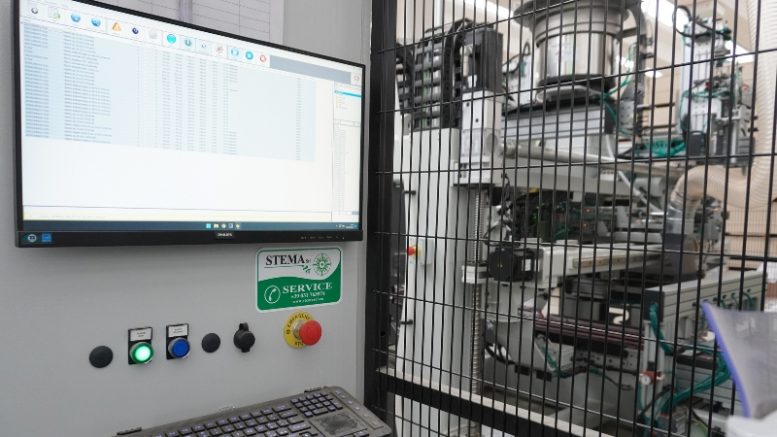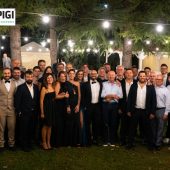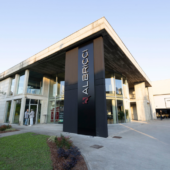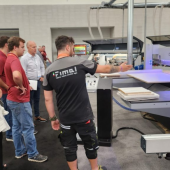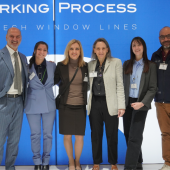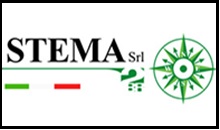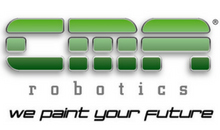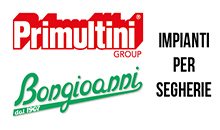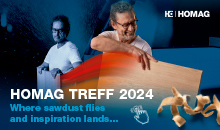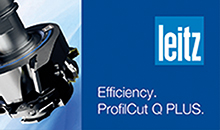It is not easy to reconcile the deep artisanal soul that has always distinguished Porro, one of the few remaining synonyms of “made in Brianza” handicraft quality, with the need to measure oneself in an increasingly complex market. “And there’s only one way to do that: to get people in production, office workers and technology to ‘talk’ to each other.”
Edmondo Caspani has no doubts, and we are very pleased to visit him again, about ten years after our first meeting, because talking with him about technology means perfectly and completely grasping what it feels like to be on the other side of the barricade, what are the needs, expectations and also the hopes of those who measure themselves with the most innovative solutions, knowing that the aim is to allow the “company organism” to express itself at its best, at every level.
“My commitment and that of many others here at Porro is to achieve the ideal mix of collaboration between people, tools and resources,” Caspani told us. “This is also why we have always invested in keeping our machinery up to date, increasing our flexibility, undoubtedly one of our most important values, what has always distinguished us and – after all – allowed us to continue to be craftsmen able to provide custom-made furniture, without any limits. With state-of-the-art machines, we do what only master carpenters could have done and this is, in few words, what Porro is today: a reality that offers a very high quality thanks to having been able to transmit, transform its artisan knowledge into a modern, complex, effective organization. We continue to process twenty different types of wood, we continue to hire carpenters convinced that ours – although fortunately done with more modern machines – is still a job that requires passion, competence, I dare say even affection… young people we meet in training schools and invite them to come and visit us, realizing their amazement when they see an organized, modern, effective company but where wood remains at the center of our work, of our being”.
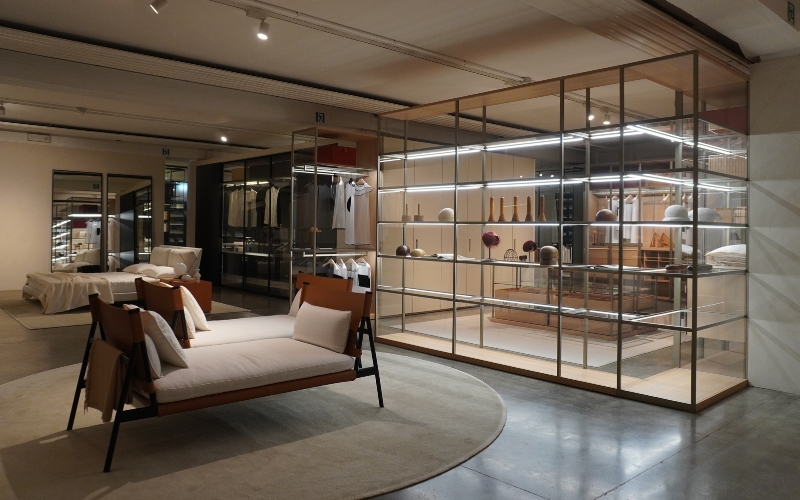
“We got on very well with Stema, because they built us a system that we designed together, so that it would perfectly meet our needs and our way of working, of understanding precision and quality. I believe that the original project has been revised a thousand times to arrive at a final solution that has solved not only all the drilling problems, but allows us to carry out many other processes, first of all the milling necessary to place the components for the electrification of our cabinets, working very often with limited thicknesses, thus adding new and highly appreciated functions but always with that elegance that is the hallmark of the Porro style. All on a single line, not only minimizing the manipulation of the elements and thus eliminating a whole series of risks, but concentrating all the processes, from milling to hardware inserting, obtaining absolute precision”.
A huge challenge for a company like yours…
“…which every day creates 800 elements per shift, one different from the other. Numbers that may seem “small”, but keep in mind that our furnishings are made from seven different melamine papers, 30 colors, 20 species and that all this can be combined as the customer wishes. And that’s not all: at Porro we work to order, so there is no possibility of stocking or having a warehouse of semi-finished products: each piece is unique, made to be placed in a specific furnishing configuration: we have been working “batch one”, as they say, for more than a decade now”.
“We are used to solving complexities rather than thinking about producing for large numbers,” said Fabio Porro, co-owner of the company we met during our visit. “We could produce much more with our machines and our organization, but we have chosen to use our technologies to continue to make “tailor-made” products, without ever denying our vocation for the high-end of the market. Our grandparents taught us to “work well” and quality is for us a matter of habit, something that we have inside: we would not know how to work otherwise, convinced that Brianza still has very important values to express, a territory that has become over the decades an efficient, well-integrated industrial district and that – having overcome the challenge of generation change – represents a fertile ground not only for wooden furniture, but also for metal and other materials.”
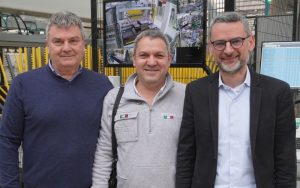
From left: Giovanni Porro, Enrico Citterio and Edmondo Caspani
“And in order to achieve these results,” Fabio Porro continued, “we need to remain extremely flexible, doing almost everything internally, so as to be sure of absolute quality. This means investing in the best possible equipment for every area of our company, from sizing to painting, from drilling-inserting operations to final packaging.
I won’t hide the fact that, despite Porro has chosen the best of each piece of equipment, it is not always easy to reconcile the quality we pursue with “lead times” that are as short as possible. We have chosen our recipe, aware that there are limits not to be exceeded, otherwise you must necessarily stop being yourself, shifting the axis of the company towards industry and leaving behind what you have always been. And at Porro we are not willing to accept it”.
“Going back to the line created for us by Stema: at the beginning we thought of something that would free us from any problem, a sort of magic wand that would make everything immediate and simple,” Edmondo Caspani continued. “It didn’t take long for us to understand with them that, if you absolutely want to achieve certain results, you risk having extremely rigid technology on your hands. This is how we understood how the right solution for us was something that increased our productivity but at the same time maintained a “rational simplicity” of use and above all allowed us to look at the possible developments of our products with a certain serenity.
A line, in other words, that will also help us on new roads in a future that may not be so far away, that accompanies us in the continuous evolution of a product that is born and lives on the solicitations of increasingly demanding customers, who in every corner of the world are looking for a composition, a piece of furniture, an environment that makes them feel at ease, that it is exactly what they had imagined for their own home…”.
So, a technological choice that is the child of many parents, if you allow this definition…
“Absolutely. As I told you today, style, quality, and an increasingly exasperated demand for customization lead to more complex furnishings with which the entire “company system” must be able to deal with, being able to have the necessary tools, mindset, management and organizational systems.
The beauty of the new Stema line comes from all this and allows us to insert a panel in line – accompanied by the bar code with all the necessary information – to be able to unload, in a few seconds, a finished element and exactly as we designed it. It may seem trivial, but I guarantee you that it is not. To achieve what we had set out to achieve, we had to find the right balance and combine the forces of four machines: the first capable of drilling and routing the edges according to any scheme, to all intents and purposes a numerically controlled machining center; the second performing on one side all the drilling and insertion of the bushings and elements that remain “flush” and are therefore more difficult to position manually. The third repeats basically the same operations on the other side, after the piece has been turned, while the fourth performs every necessary operation on the short sides, whether it is pins, joints, shelf supports and all those processes that represent a challenge if they have to be done manually. Finally, a detail of which we are very proud, a laser system that codes, writes on each element the code that distinguishes it, a serial number that makes it unique, unrepeatable and obviously traceable”.
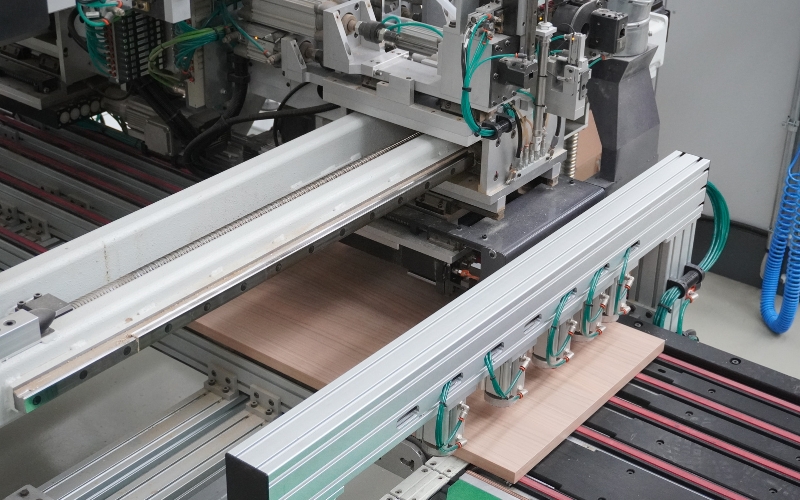
“For us at Stema, it was a great challenge,” said Enrico Citterio, co-owner of the Brenna-based company. “We had a long discussion with the owners, the top management, Porro’s managers to imagine what the right solution could be. And we made many changes together: I remember, just to give an example, that in the first configuration we had even provided four fixed routers to achieve certain results, but then we agreed that we could have obtained a similar result by relying on a “tool changer” that worked on a single center according to certain settings. And Porro liked it, in this continuous exchange of requests, ideas and proposals that then led to the line that – I must admit – today is also a source of pride for us.
We worked in a practical way, stimulated to find solutions that not only met the specific requests, but that left room for possible future developments.
Hence the decision to configure a machine that had an adequate length – about forty meters, sixty if you add the space dedicated to assembly carried out by the operators – to meet not only the physical and structural needs of an undoubtedly very “rich” configuration, but also to make any intervention simple, including the possibility of adding new aggregates in the future to create new opportunities on the finished product.
All managed remotely, with a series of cameras that allow you to monitor every step with complete peace of mind”.
THE STEMA LINE FOR PORRO
The first element is the loader that picks up each individual element from the mixed stack of panels prepared by the sizing department and sends it to automatic control and measurement before insertion into the actual line.
There is a second loading system, i.e. a “hedgehog” that also provides for the “batch one” processing of special or oversized panels and reworking operations that are inserted without any problem in the programming flow.
The Stema line – perfectly modular, according to the tradition of the Brianza-based manufacturer, in order to better manage workloads – is composed of two “Grafias C” machines that provide for machining on the two sides of the panel, preceded by a “Grafias V” pass-through router, made specifically for Porro, and a “Mizar” dedicated to drilling and insertion. A total of over 80 axes are controlled, in a line where the suction and cleaning systems – fundamental for the final quality of the workpiece – are combined with a line logic that allows to achieve excellent production levels but above all the quality and “care” imposed by Porro standards.

